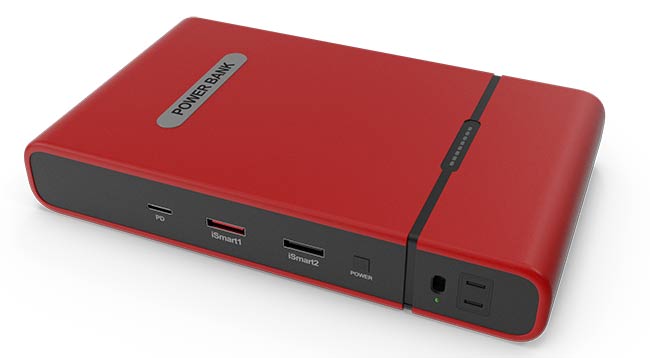
The rechargeable battery is a necessity in today’s wireless world. From all types of wireless audio devices like headphones, headsets, earbuds, and AirPods as well as any other devices such as but not limited to computer mice to weed whackers, consumers are pulling the plugs on tradition and opting for the enhanced convenience and extended range of use provided by cordless appliances. However, the rosy benefits of going wireless would certainly pale, if not for rechargeable batteries.
Table of Contents
- Rechargeable Battery Overview
- How Batteries Work
- Rechargeable vs. Non-Rechargeable (Disposable) Batteries
- Battery Type Comparison Chart
- Related Questions
Rechargeable Battery Overview
You can’t beat a rechargeable battery for longevity. Although when you make the switch to rechargeable batteries, you might first be disappointed that rechargeable batteries generally lose power quicker than the old standbys do.
There’s no near-death experience for the traditional battery. When it’s dead, it’s gone! Yet, when the traditional battery bites the dust, the rechargeable rises from the ashes to deliver hundreds, sometimes thousands more hours of use, literally keeping today’s unplugged owners from battery bankruptcy! The actual two classes of batteries are primary (non-rechargeable batteries) and secondary (rechargeable batteries). Both types of batteries share the same basic components:
- A Positive electrode, the cathode
- A Negative electrode, the anode
- A Separator
- In a Chemical Solution, the electrolytes
However, unlike primary batteries, the chemical reaction of rechargeable batteries is reversed, allowing you to recharge the battery. Although nothing lasts forever, some secondary batteries can be recharged over 1000 times.
There are several types of small appliance battery chargers in use today such as Audio devices and wireless headphones. Cordless and cell phones are usually sold with a plug-in accessory that recharges your phone when it’s not in use. Cordless power tools, such as drills and screwdrivers, are marketed in a package that contains the tool, two batteries, and a battery charger. Of course, those battery chargers that hold a spare set of your AA, A, D, or other household batteries are still available, too.
Another example of a device that uses rechargeable batteries is the power bank.

The industry offers a broad selection of battery types, rechargeable as well as primary batteries. However, most experts agree that the best all-around use battery is the rechargeable Nickel-Metal Hydride (NiMH) which made its predecessor, the NICAD, obsolete.
How Batteries Work
Generally speaking, batteries are categorized into two classes:
- Primary batteries are the non-rechargeable battery that we’ll call standard.
- Secondary batteries, the rechargeable batteries.
Both classes of batteries work in about the same way except that when rechargeable batteries lose power, you recharge them and when standard batteries lose power, you throw them away.
What’s in a Battery?
Batteries contain one or more cells. Each cell consists of two different types of metal, the electrodes. The cathode is the positive (+) electrode of the battery and the anode gives off a negative (-) charge. On household batteries, such as flashlight batteries, the cathode is the end with the bump, and the anode is the flat end. These ends are the battery terminals.
The electrodes are always separated – sometimes by space and sometimes by an inserted separator – and are immersed in a chemical, the electrolyte. The chemically-based electrolyte reacts with the two different metals and determines which one is positively charged and which is negatively charged.

All-Energy Seeks Balance
The meeting of positive and negative energy creates a balance. The ions on the cathode are fixed, but the negative ions (electrons) on the anode are free to move. However, the electrolyte keeps most of the electrons from passing through it. If it didn’t, the positive and negative charges would quickly be balanced and neutralized. So, if the electrons are to create a balance in the cell, they must move from the negative end of the battery and find a path back to the fixed ions on the positive end of the battery.
If you look inside a flashlight, you’ll see a wire or flat piece of metal that starts at the back end of it and extends to the flashlight bulb. This wire is the conductor that lets the electrons move along it. The conductor connects to a load, in this case, the flashlight bulb. The electrons continue through the wires contained within the load and finally complete the circuit when they exit the bulb and finally reach the cathode.
This flow of electrons is what we call the current. When there’s a break in the conductor or the load, because they are unable to complete the circuit, the electrons stop in their tracks.
Dead Batteries
The shelf life of a standard battery depends on the composition of the electrolyte and the types of metals used in the battery’s construction. Although electrolytes impede the flow of electrons to the cathode, some do manage to wiggle through. Additionally, the electrolyte continually reacts with the metal components of the battery. Over time, this chemical reaction depletes the supply of new electrodes and the standard battery ‘dies’. The death of a battery occurs when the positive and negative charges are in balance. Unfortunately, it usually happens when you least expect it and most need your battery to work!
The reason why some batteries are rechargeable and some are non-rechargeable is easily explained by comparing electrolytes to water. When you heat a pan of water, it turns to steam and once the pan runs dry, the water is gone – you can’t put it back in the pan. However, if you cool a pan of water, it turns to ice but, when heated again, you have a pan full of water.
The chemical reaction in a rechargeable battery generally isn’t strong enough to fry the battery. Yet, although the chemicals in a rechargeable battery don’t really freeze, rechargeables can “go cold”. A strong benefit of the rechargeable battery is that when it “freezes” it can be revived in a battery charger.
Rechargeable vs. Non-Rechargeable (Disposable) Batteries
Used to be the easiest way to replace a dead battery was to pull out the dead one, bring it to the store and buy its clone, but these days, the easiest way isn’t always the best. To begin, most new appliances are sold “batteries not included” and, with some exceptions, even when batteries are included, they’re low-grade, non-rechargeable varieties.
Non-rechargeable batteries are called primary batteries, not because they’re first in quality but because they were invented first. Rechargeable batteries, classified as secondary batteries, are a must-have for many of today’s modern appliances and tools.

Recharge or re-purchase?
When comparing rechargeable batteries to non-rechargeables, the facts alone can be confusing!
- Non-rechargeable batteries have a longer shelf life’ but rechargeables last longer! It’s true. The old stand-by, non-rechargeable battery, has a longer shelf life than its rechargeable counterpart. However, when you buy a pack, keep the extras in your freezer. Keeping primary batteries cold slows down the chemical reaction that makes them go dead, and when a primary battery goes dead — it’s dead and gone! When you buy rechargeable batteries, as your batteries recharge, the chemical reaction is reversed. Keeping a set of extra batteries in your battery recharger ensures that you’ll always have a fresh power supply ready when you need it.
- Non-rechargeables are cheaper but rechargeable batteries are more cost-efficient! You’ll pay less at checkout for most brands and sizes of non-rechargeable batteries, making non-rechargeables look like the better buy. However, rechargeable batteries generally provide you with hundreds and even thousands more hours of use and in the ‘long-run’ cost less than primary batteries.
So, are non-rechargeable batteries obsolete?
No. Some non-rechargeable batteries have a place in every home. For instance, because rechargeable batteries lose their charge quicker than most non-rechargeables, they are not recommended for long-term use in appliances such as smoke detectors and battery-operated clocks or high-drain devices such as digital cameras.
Before buying batteries for a new appliance, it’s usually best to follow the manufacturer’s recommendations. Yet, while it’s easy to figure out what size battery to buy, how do you choose the right type of battery for an old appliance?
Another fact to take note of when replacing rechargeable batteries is that most batteries need battery chargers uniquely built for their type.
The best way to compare battery types for either new purchase or replacement is by using a handy chart like our Battery Comparison Chart.
Battery Type Comparison Chart
Why are there different kinds of batteries? What are the advantages or disadvantages of different battery types? Learn the ins and outs of the different battery types with our helpful comparison chart.
| Type | Facts |
| Alkaline | Non-Rechargeable–Available in both classes (primary and secondary) and named for their Alkaline electrolyte, these batteries first gained popularity in the 1970s. Notable for its long shelf life the alkaline non-rechargeable battery is the most common type of household battery. Although standard Alkaline batteries aren’t a good choice for use in high-drain devices like digital cameras, some manufacturers have recently developed new Alkaline battery types, especially for use in high-drain items. Rechargeable– Alkaline rechargeable batteries are lower capacity (don’t hold a charge as long) than the more popular NiMH rechargeables Additionally they aren’t ‘fully rechargeable’. Each time you recharge them, Alkaline batteries lose a portion of their capacity and additionally offer fewer recharge cycles (as few as 10) than the NiMH. The advantage of the rechargeable Alkaline over the NiMH or the NiCAD is that it loses its charge gradually, giving you some notice that it’s time to switch batteries. NiMH and NiCADS are more prone to steep drops in power when they’re ready to be recharged. Another benefit is that Rechargeable Alkalines put out more voltage than NiMH batteries (1.5 V as compared to 1.2 V). So, they make the light a little brighter in your LED flashlight. Rechargeable Alkalines also have a lower self-discharge rate than NiMHs, making them more able to sit on the shelf between periods of use. One advantage of Alkaline batteries is that neither type contains toxic metals and both types can be disposed of in your trash. Of course, in most cases you’ll throw out fewer rechargeables than non-rechargeables, making the rechargeable Alkaline battery the better buy of the two. |
| Lithium | Lithium batteries come in two types– the Lithium-ion battery pack and Lithium-photo batteries. Rechargeable– Lithium-ion batteries are the batteries most often used in good laptops, cell phones, and camcorders. Rechargeable, but unavailable in general household sizes (AA, B, D, etc.), the lithium-ion battery has an excellent power-to-rate ratio. Lithium-ion batteries are usually recharged either in a special recharger or when installed in the unit they power. Non-Rechargeable–Lithium photo batteries are not rechargeable and are usually more expensive at the checkout than other non-rechargeable batteries. Used in cameras because of their ability to handle and supply power surges, the lithium photo battery is also the battery of choice for remote-controlled toys. Also a good choice for long-term use in appliances like battery-operated clocks and smoke detectors, the 9-volt Lithium has a low self-discharge rate, a long shelf life, and may last up to 10 years before it needs replacement substantially off-setting its more expensive price. A major disadvantage of lithium batteries is that they contain toxins and require disposal at a hazardous waste station. |
| Nickel-Cadmium (NiCad) | Rechargeable–The forerunner to the NiMH, NiCAD rechargeable batteries are now nearly obsolete. They are lower capacity than either NiMH or Alkaline rechargeables and have the further disadvantage of containing toxic metals that require hazardous waste disposal. NiCAD batteries are also said to suffer from the ‘memory effect’. If you recharge a NiCAD before the power supply is nearly drained, the battery ‘remembers’ the last point at which it was recharged and will never become fully charged again. |
| Nickel-Metal Hydride (NiMH) | Rechargeable– NiMH rechargeable batteries have replaced the NiCAD. Lightweight and rechargeable, the NiMH has a higher capacity than the NiCAD plus you can throw it away since it doesn’t contain toxic metals and it isn’t classed as a hazardous waste item. The main disadvantage of the NiMH is that it comes in different capacities. So you need to check to be sure that the NiMH you buy has the capacity your device needs to operate. High-capacity NiMH batteries may not charge completely in some battery chargers. A final present disadvantage to NiMH batteries is that like the NiCADs, they have less voltage than Alkaline batteries. However, as technology changes, more manufacturers develop appliances that accept lower voltages. Additionally, in devices that require only one or two batteries, the slight difference in voltage won’t usually make a difference in performance. The shelf life of the NiMH is short, just two to three months, and when not in use, they self-discharge at a rate up to 25% per month. So the NiMH isn’t a good choice for rarely activated devices like emergency flashlights and smoke detectors. |
| Zinc | Non-rechargeable– Often called General Purpose or Heavy Duty Batteries, Zinc-carbon and Zinc-chloride batteries don’t have the capacity of and are more prone to leak than Alkaline batteries. Sold most often in AA, C, and D sizes, these batteries were first the forerunner and later an inexpensive alternative to Alkaline batteries. However, reductions in the price of alkaline have made both Zinc-Carbon and Zinc-Chloride batteries all but obsolete. |
Related Questions
What type of rechargeable battery lasts the longest?
The longest-lasting battery could basically transcend eras. One of the best rechargeable batteries that last for a very long time is the “Panasonic Eneloop AAA Batteries“, it can retain up to 70% charge even being stored for a decade.
Are alkaline or lithium batteries better?
Lithium batteries perform a longer lifespan than their alkaline equivalents, as lithium batteries outlast the alkaline batteries 10 cycles longer, yet, lithium batteries are more expensive than their alkaline equivalents.
Are all rechargeable batteries the same?
No, since there are 4 main types of rechargeable batteries for personal and home use that differ in how they produce their charge chemically, each has its own strengths and usefulness for different purposes including nickel-cadmium (NiCD or NiCaD), lithium-ion, alkaline, and nickel-metal hydride (NiMH).
Do NiMH batteries last longer than alkaline?
Yes, NiMH rechargeable batteries are 2-4 times long-lasting than alkaline or NiCd rechargeable batteries. thus, they can be (charged/discharged) for up to 500-1,000 cycles.

